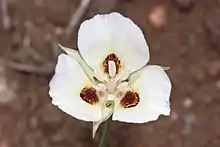Calochortus dunnii
Calochortus dunnii is a rare species of flowering plant in the lily family known by the common name Dunn's mariposa lily.
| Calochortus dunnii | |
|---|---|
 | |
| Scientific classification | |
| Kingdom: | Plantae |
| Clade: | Tracheophytes |
| Clade: | Angiosperms |
| Clade: | Monocots |
| Order: | Liliales |
| Family: | Liliaceae |
| Genus: | Calochortus |
| Species: | C. dunnii |
| Binomial name | |
| Calochortus dunnii Purdy | |
Distribution
The plant is endemic to the Peninsular Ranges, native to southern San Diego County, California; and northern Baja California state, Mexico. It is known from only a few occurrences in chaparral, grassland, and Closed-cone coniferous forest habitats, at 185–1,830 feet (56–558 m) in elevation in the Cuyamaca Mountains, Laguna Mountains, and others.[2][3]
Description
Calochortus dunnii is a perennial herb growing a slender, branching stem up to 60 centimeters tall. The waxy, channeled basal leaf is 10 to 20 centimeters long and withers at flowering.
The inflorescence bears 2 to 6 erect bell-shaped flowers. Each flower has three sepals and three white or pinkish petals. The petals are up to 3 centimeters long and spotted with red and yellow near the bases, where there are patches of yellow hairs.
The fruit is a narrow, angled capsule 2 to 3 centimeters long.
Conservation
Although the plant isn't seriously impacted by any one major problem,[1] the main threat to the existence of this rare species is collecting by admirers of the attractive flowers.[4]
References
External links
 Media related to Calochortus dunnii (category) at Wikimedia Commons
Media related to Calochortus dunnii (category) at Wikimedia Commons Data related to Calochortus dunnii at Wikispecies
Data related to Calochortus dunnii at Wikispecies- Calflora Database: Calochortus dunnii (Dunn's mariposa lily)
- Jepson Manual Treatment of Calochortus dunnii
- USDA Plants Profile for Calochortus dunnii (Dunn's mariposa lily)
- Flora of North America
- UC Photos gallery — Calochortus dunnii
